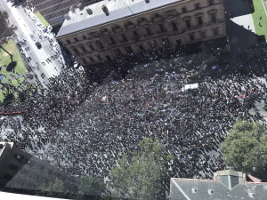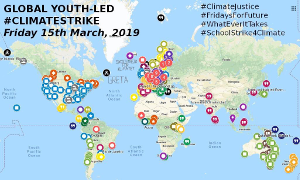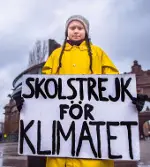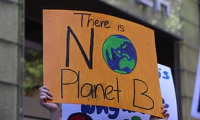|
Climatestrike Hits 2,000 Cities Worldwide
March 16, 2019
Students turned out in the tens of thousands in more than 2,000 cities and towns in 120 countries for Climatestrike, a walkout to call attention to the dangers of climate change. Protests took place in population centers large and small, at schools and public places, at city halls and national capitals. Students in New Zealand got things rolling. New Zealand Prime Minister Jacinda Ardern addressed a rally on the west coast of the country's North Island. Ardern said that students shouldn't wait until they were of voting age to take political action. A large crowd gathered in Sydney, Australia. One student told the crowd, "This right here, this right now is what democracy looks like." Students at the very large strike in Melbourne called the leader of one of the country's major political parties to urge him to get behind measures to deal with problems stemming from climate change. He didn't answer, and the students left a pointed message. In Montreal, more than 110,000 Quebec university students joined the strike. Students in that city disrupted morning classes by forming human chains around school buildings. In London, students holding signs and chanting slogans gathered in Parliament Square with a few select messages for U.K. lawmakers, among them "We want you to panic" and "The greatest threat to the planet is the belief that someone else will save it." The popular "There is no Planet B" slogan was prominent on signs and placards at a large protest in Berlin, where more than 20,000 students and adults gathered in the city center. Another sign there read "March now or swim later," referring to rising sea levels that threaten coastal and island populations. Authorities in Austria and Switzerland reported crowds of at least 10,000 in Vienna and Lausanne, respectively. Venice reported a crowd of 15,000. The crowd in Helsinki, the Finnish capital, was smaller but no less spirited, with one placard reading "Dinosaurs thought they had time, too!" Many of the protests were in government centers, in state and country capitols. A few lawmakers, such as the Labor Party leader in Australia targeted by the crowd's live phone call, had no comment. Other politicians were happy to support the Climatestrike efforts. U.K. Secretary Michael Gove applauded the strikers, as did U.K. Labour Party leader Jeremy Corbyn. Education secretaries in both parties spoke out against the school-day strikes, urging students to find a way to protest that didn't involve missing school. The protesters found support at the highest levels. U.N. Secretary-General Antonio Guterres added his thoughts: "Young people can, and do, change the world. You understand we are in a race for your lives; your commitment & activism makes me confident we will win it." The global action is called Climatestrike and includes protests in the United States and 80 other countries, from every continent except Antarctica. According to 13-year-old Alexandria Villasenor, the co-leader of the U.S. protest event, 400 strikes will occur in the U.S. alone. Climatestrike is part of a global youth environmental movement that has seen a rapid upturn in the last two years thanks to the efforts of Swedish teenager Greta Thunberg has gained worldwide recognition for herself and for her cause. She has her own TED talk, she has appeared on countless interview shows, and she addressed world leaders at the World Economic Forum in Davos and at the U.N. Climate Conference COP 24. Thunberg had this to say at the World Economic Forum in Davos, Switzerland, in January: “I am here to say our house is on fire. "I don’t want your hope. I want you to panic. I want you to feel the fear I feel every day. And then I want you to act. I want you to act as if you would in a crisis." She now attends school four days a week and then, on Friday, assumes her protesting post. She has started a worldwide movement called Fridaysforfuture. Thunberg herself spoke at a Climatestrike event in Hamburg, Germany. Like Thunberg, Alexandria Villasenor, the 13-year-old co-leader of the U.S. movement, has skipped class every Friday since December to protest against inaction on climate change. The movement has already shown signs of life around the world:
|
Social Studies for Kids |
Social Studies for Kids
copyright 2002–2024
David White






 Thunberg. On Aug. 20, 2018, Thunberg went not to school but to Parliament in Stockholm to protest. She had a wooden sign and some flyers, containing facts about carbon footprint and climate change. She spent what would have been her schoolday hours in front of Parliament, holding up the sign and handing out flyers. She went back the next day and found other people ready to stand with her. Every school from then until Sept. 9–the day of her country's general elections–Thunberg spent outside Parliament, holding her own vigil; the crowds with her grew and grew. She wanted to call attention to the fact that her country's environmental policies were not necessarily in line with the
Thunberg. On Aug. 20, 2018, Thunberg went not to school but to Parliament in Stockholm to protest. She had a wooden sign and some flyers, containing facts about carbon footprint and climate change. She spent what would have been her schoolday hours in front of Parliament, holding up the sign and handing out flyers. She went back the next day and found other people ready to stand with her. Every school from then until Sept. 9–the day of her country's general elections–Thunberg spent outside Parliament, holding her own vigil; the crowds with her grew and grew. She wanted to call attention to the fact that her country's environmental policies were not necessarily in line with the 

